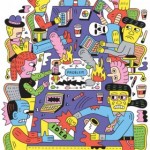Here is an alternative view, published in the NYT, on our earlier blog, ‘Is Small Beautiful, Again?’. Its thesis is that creativity occurs more often in isolation. It’s relevant to many public relations and corporate affairs (public affairs) practitioners who work in open plan offices. I’ve always been concerned with open plan; the decision for it is often more about saving costs (not to be ignored) rather than about productivity.
I’ve always been concerned with open plan; the decision for it is often more about saving costs (not to be ignored) rather than about productivity.
The article is thought provoking. If you go to the NYT article you will see that judgement has been passed by many angry critics, as well as passionate supporters.
The Rise of the New Groupthink
By SUSAN CAIN Published in NYT: January 13, 2012
SOLITUDE is out of fashion. Our companies, our schools and our culture are in thrall to an idea I call the New Groupthink, which holds that creativity and achievement come from an oddly gregarious place. Most of us now work in teams, in offices without walls, for managers who prize people skills above all. Lone geniuses are out. Collaboration is in.
But there’s a problem with this view. Research strongly suggests that people are more creative when they enjoy privacy and freedom from interruption. And the most spectacularly creative people in many fields are often introverted, according to studies by the psychologists Mihaly Csikszentmihalyi and Gregory Feist. They’re extroverted enough to exchange and advance ideas, but see themselves as independent and individualistic. They’re not joiners by nature.
One explanation for these findings is that introverts are comfortable working alone — and solitude is a catalyst to innovation. As the influential psychologist Hans Eysenck observed, introversion fosters creativity by “concentrating the mind on the tasks in hand, and preventing the dissipation of energy on social and sexual matters unrelated to work.” In other words, a person sitting quietly under a tree in the backyard, while everyone else is clinking glasses on the patio, is more likely to have an apple land on his head. (Newton was one of the world’s great introverts: William Wordsworth described him as “A mind for ever/ Voyaging through strange seas of Thought, alone.”)
Solitude has long been associated with creativity and transcendence. “Without great solitude, no serious work is possible,” Picasso said. A central narrative of many religions is the seeker — Moses, Jesus, Buddha — who goes off by himself and brings profound insights back to the community.
Culturally, we’re often so dazzled by charisma that we overlook the quiet part of the creative process. Consider Apple. In the wake of Steve Jobs’s death, we’ve seen a profusion of myths about the company’s success. Most focus on Mr. Jobs’s supernatural magnetism and tend to ignore the other crucial figure in Apple’s creation: a kindly, introverted engineering wizard, Steve Wozniak, who toiled alone on a beloved invention, the personal computer.
Rewind to March 1975: Mr. Wozniak believes the world would be a better place if everyone had a user-friendly computer. This seems a distant dream — most computers are still the size of minivans, and many times as pricey. But Mr. Wozniak meets a simpatico band of engineers that call themselves the Homebrew Computer Club. The Homebrewers are excited about a primitive new machine called the Altair 8800. Mr. Wozniak is inspired, and immediately begins work on his own magical version of a computer. Three months later, he unveils his amazing creation for his friend, Steve Jobs. Mr. Wozniak wants to give his invention away free, but Mr. Jobs persuades him to co-found Apple Computer.
The story of Apple’s origin speaks to the power of collaboration. Mr. Wozniak wouldn’t have been catalyzed by the Altair but for the kindred spirits of Homebrew. And he’d never have started Apple without Mr. Jobs.
But it’s also a story of solo spirit. If you look at how Mr. Wozniak got the work done — the sheer hard work of creating something from nothing — he did it alone. Late at night, all by himself.
Intentionally so. In his memoir, Mr. Wozniak offers this guidance to aspiring inventors:
“Most inventors and engineers I’ve met are like me … they live in their heads. They’re almost like artists. In fact, the very best of them are artists. And artists work best alone …. I’m going to give you some advice that might be hard to take. That advice is: Work alone… Not on a committee. Not on a team.”





